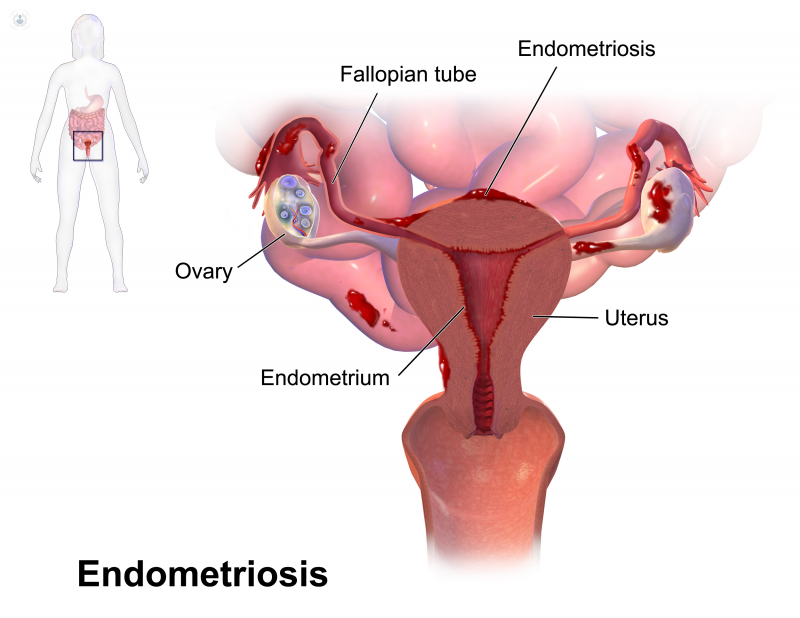Endometriosis affects 15% of women of childbearing age
Written by:Endometriosis is a condition characterized by the presence of endometrial tissue, which is the mucosa or lining of the uterus in abnormal locations. The place in which they occur most often endometriosis implants is the ovary, but may appear in other less common locations like the back of the cervix, uterine ligaments, bladder or bowel. It is extremely rare to appear endometriotic implants in other places such as the lungs, although there are also cases.
Possible Causes of Endometriosis
For many years it has tried to find the cause of endometriosis. However, today, the mechanism by which the disease occurs remains unclear. There are several theories:
- Retrograde menstruation during the rule of the endometrial tissue could pass through the tubes, abdomen and colonize the ovary or other tissues.
- immune disorders
- Endocrine mechanisms: estrogen could promote the development of the disease.
As progress is to try to understand the mechanism by which endometriosis occurs, we will also have more weapons to treat this pathology.

Symptoms of Endometriosis
Symptoms of the disease are highly variable. In some cases even disease patients are asymptomatic and incidentally diagnosed by the finding of a cyst on ultrasound.
The main symptom presented by patients with endometriosis is pain. Classically is an intense pain that occurs during menstruation and occurs as a result of bleeding endometrial implants. Depending on where endometriosis implants are placed, patients may also experience pain during sexual intercourse (dyspareunia), with bowel movements (dyschezia) or urination (dysuria).
If there instentino implants, the patient may also have digestive symptoms such as diarrhea, constipation and in very extreme pictures, intestinal obstruction.
Patients with endometriosis may have fertility problems. Endometriosis affects oocyte reserve and egg quality as healthy ovarian tissue is reduced by the presence of the implants. When a patient with endometriosis want children, it is important to warn that no delay childbearing and offer the option to preserve their fertility through oocyte vitrification in case you want to wait.
How is endometriosis diagnosed?
First, it is important to patient medical history to identify their symptoms and abdominal and gynecological physical examination.
The diagnostic imaging test to be performed when there is a suspicion of endometriosis is vaginal ultrasound. This will allow the specialist in Assisted Reproduction assess the presence of endometriosis, cysts known as endometriomas, ovary or suspect the presence of implants in other locations such as behind the cervix.
Determining blood marker CA 125 can be helpful to confirm the suspicion that a cyst observed by ultrasonography case of an endometrioma and control the development of the disease. However, this type of markers should always be assessed in a clinical context because, by themselves, have no diagnostic significance.
When the ultrasound diagnosis is not clear, or when you suspect deep endometriosis implants in other locations inaccessible to transvaginal ultrasound as bladder, bowel or pelvic blood vessels, pelvic MRI is recommended.
Moreover, endoscopic ultrasound may help assess transrectal implants straight and level with the depth level of the intestinal wall, which is important when considering treatment.
And in cases where no proof image has been sufficient to obtain a clear diagnosis, you can resort to exploratory laparoscopy: introducing a camera through the abdomen, you may be valued inside the abdominal cavity. This is a surgical procedure and as a diagnostic test is relegated to the last option.
Treatment of Endometriosis
The treatment of endometriosis is highly variable and depend on the symptoms of the patient:
- Pain management : is in first line, with analgesics and anti - inflammatories to relieve the painful symptoms of the patient.
- hormonal treatment. For a long time it was thought that if hormones were used to suppress ovarian function and menstruation may disappear monitored for the development of the disease. However, today this is a treatment obsolete and it does not control the progression of endometriosis and produces many side effects. Oral contraceptives have also shown to be effective in controlling the disease but can help control pain during menstruation. Instead, the hormone-releasing intrauterine device (IUD) can be an alternative to improve pain and decreasing the thickness of the endometrial lining.
- surgical treatment. Endometriosis surgery is usually performed laparoscopically, that is, inserting a camera into the abdomen. The type of surgery performed depends on the size and location of the implants. In some cases are relatively simple interventions consisting remove the endometriotic ovarian tissue, but sometimes are very complex surgeries that require the involvement of multiple specialists (gynecologists, surgeons, urologists ...). In cases where there is intestinal implants affecting much of the thickness of the rectal wall, it may be necessary to remove part of the large intestine and make a colostomy for a while. If the implant severely affects the bladder or ureters way, you may also need to remove a portion thereof.
- Infertility Treatment. The assisted reproduction technique that provides better results for patients with endometriosis is in vitro fertilization. After surgery endometriosis pregnancy is recommended as soon as possible.



